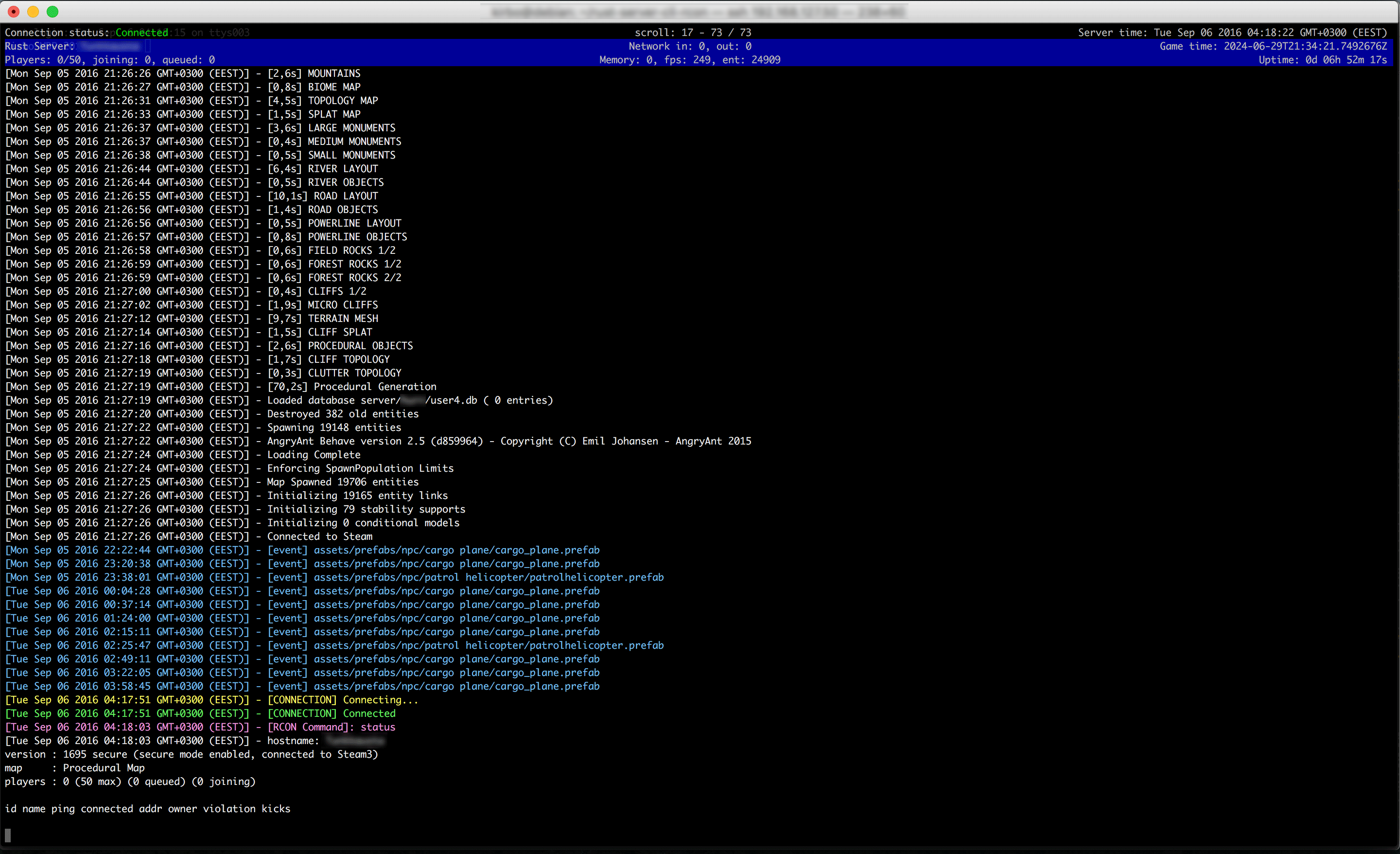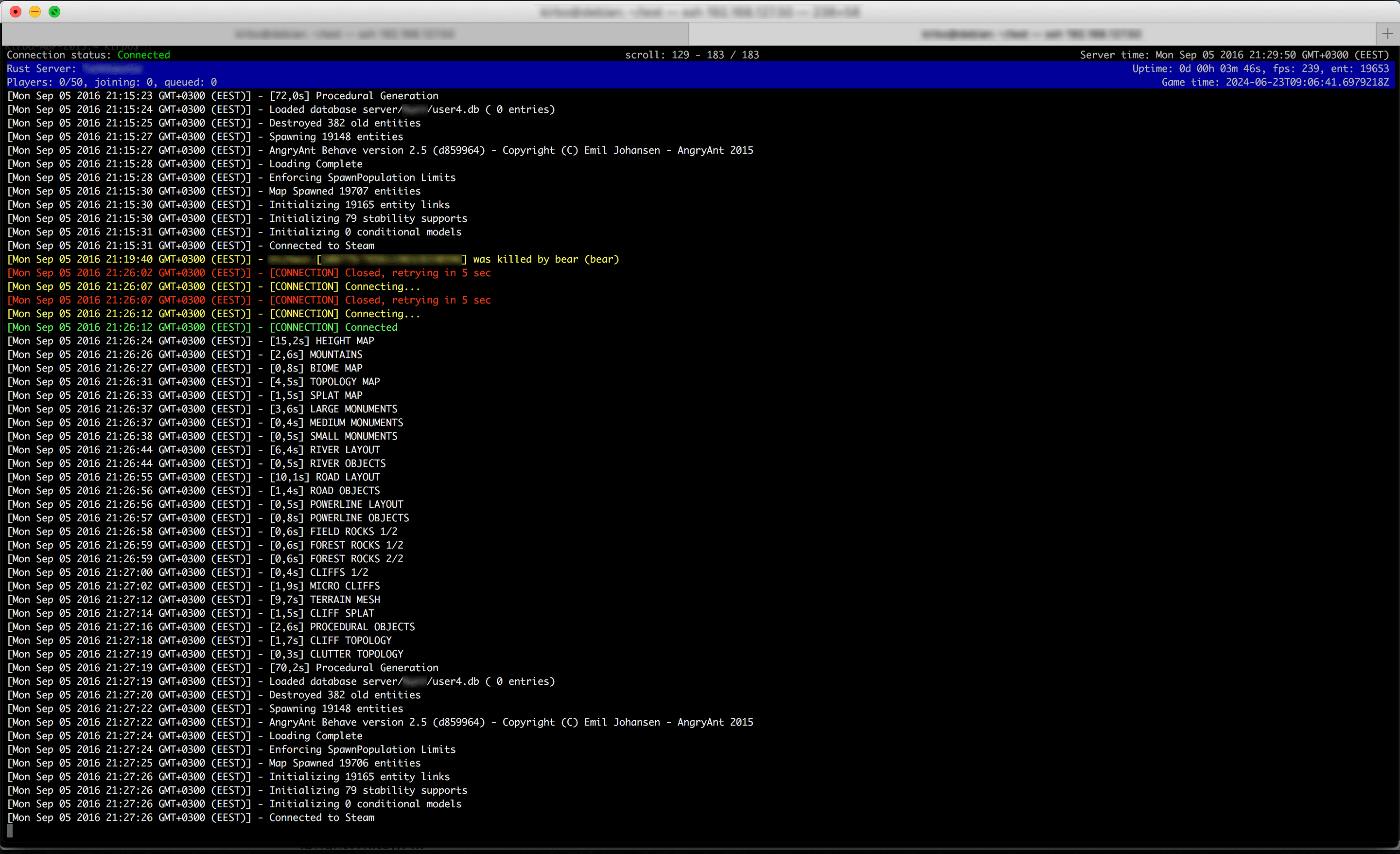Command Line Interface RCON Client for Rust Server
Check the instructions how to install Node.js and NPM on your OS: https://nodejs.org/en/download/package-manager/
# Clone this repository
git clone https://github.com/kirbo/rust-server-cli-rcon.git
# Change directory
cd rust-server-cli-rcon
# Install dependencies
npm install
# Copy sample config file
cp sample.config.js config.js
# Edit the file you just copied with your favorite editor, e.g.
nano config.js
# Make sure you have "+rcon.web true" in your Rust server,
# otherwice this wont work (at least for now)..
# Start the client
nodejs index.js
You can configure multiple servers into config.js and connect to any
of them, such as:
# This connects to the first server in config.js
nodejs index.js
# If you specify the "server" argument, you can connect to another
nodejs index.js server=another
# And the last one
nodejs index.js server=someOther
The first 3 rows (Header) contains some information of this client and the Rust server you connected to.
Last line is the input field you can type the RCON commands to.
The input has autocomplete for some predefined commands, simply tap
Tabulator to access the autocomplete menu, or type a part of the
command you want to use, such as ser and press TAB and it will be
autocompleted to a word server and if you press TAB again, you will
get a list of all the predefined commands starting by server, e.g.:
- serverinfo
- server.writecfg
- server.hostname
- server.clienttimeout "time"
- server.maxplayers "amount"
- server.pvp true/false
- server.steamgroup "steamgroup ID"
You can navigate the autocomplete menu via Left and Right arrow keys and select the currently hilighted one by pressing Enter, or cancel the autocomplete by pressing ESC.
You can autocomplete serverinfo like this:
- type
se - press TAB (it will now be
server) - type
i - press TAB (it will now be
serverinfo)
OR
- type
s - press TAB once
- press Enter twice
The input has history, you can navigate the history of commands you sent in the current session, via Up and Down arrow keys.
You can scroll the backlog via Page Up and Page Down keys. Currently default maximum backlog length is set to 10000 rows.
Simply press CTRL + C and you will be asked "Are you sure you want to quit",
- press Y or Enter if you want to close the client, or
- press N or ESC if you don't want to close the client.
Closing the client wont close the Rust Server you connected to.
At the moment there is only one custom command, but more will come.
getlog length, e.g.getlog 1000which will request last 1000 lines from Rust Server, parses the log lines and replaces the console log with it. This is handy if you want to check the history.
I personally got sick and tired of the current Rust Server tools.
There seemed not to be any out-of-the-box console (at least on Linux,
as far as I know) and WebRCON provided by Facepunch only works in a
browser (not even on links). I wanted a console which could be run on
a server without any desktop GUI and without any modifications done to
the Rust Server (i.e. Oxide), so that one could run a vanilla Rust
Server and still be able to locally manage the server in command line.
One reason also was to improve my Node.js skills and this seemed to be a good project for that.
- List all the commands in autocomplete menu
- Creating separate websocket for this client to connect to.
This websocket would run on the game server and it could:
- Run on a separate port,
- Provide more specific information of the server itself, including:
- Server load (cpu, memory, network, I/O, etc),
- Sensor information (e.g. temperatures),
- Ability to log RCON commands into a logfile(s),
- Push notifications to all clients when another client connects or disconnects,
- Push RCON commands and responses to every clients backlog,
- This would also ease the load on the Rust Server itself, since
only one client would poll the
serverinfo, instead of every client which is open, - Provide a range of log, instead of last N number of lines. This is useful if you want to see a specific range of log (e.g. lines 0 - 100), rather than show all the lines and you need to scroll all the way to the first line to see the first 100 lines,
- Etc...
- Ability to save output into logfile(s)
- Refactoring the code
- Refactoring the code
- Refactoring the code
- Turning this package into a proper NPM Module

